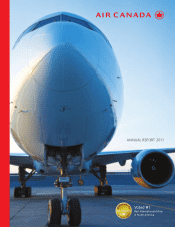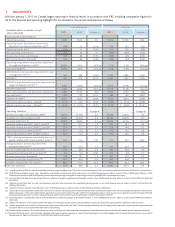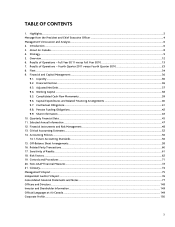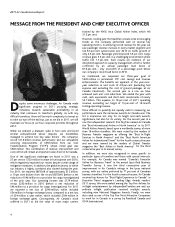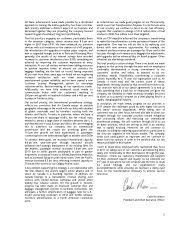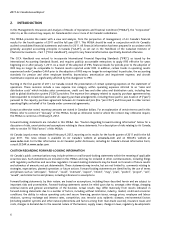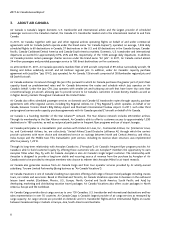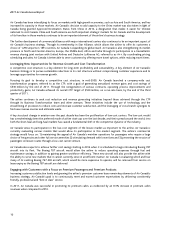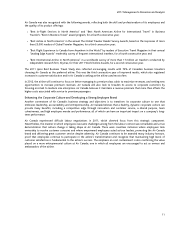Air Canada 2011 Annual Report Download - page 10
Download and view the complete annual report
Please find page 10 of the 2011 Air Canada annual report below. You can navigate through the pages in the report by either clicking on the pages listed below, or by using the keyword search tool below to find specific information within the annual report.2011 Air Canada Annual Report
10
Air Canada has been intensifying its focus on markets with high growth economies, such as Asia and South America, and has
increased its capacity in those markets. Air Canada’s decision to add capacity to the China market was also taken in light of
Canada being granted Approved Destination Status from China in 2010, a designation that makes it easier for Chinese
nationals to visit Canada. China and South America are both important strategic markets for Air Canada and the development
of its franchise in those markets continues to be an important element of the airline’s business strategy.
The further development of commercial alliances with major international carriers also continues to be an important aspect of
Air Canada’s business strategy. Through its membership in Star Alliance, which allows the airline to offer its customers a
choice of 1,290 airports in 189 countries, Air Canada is expanding its global reach. Air Canada is also strengthening its market
presence in North and Central America, Europe, the Middle East, Africa and India through its participation in a transatlantic
revenue sharing joint venture with United Airlines and Deutsche Lufthansa AG, referred to as A++. By coordinating pricing,
scheduling and sales, Air Canada is better able to serve customers by offering more travel options, while reducing travel times.
Leveraging New Opportunities for Revenue Growth and Cost Transformation
A competitive cost structure is a key element for long-term profitability and sustainability. A key element of Air Canada’s
business strategy is to pursue sustainable reductions in its cost structure without compromising customer experience and to
leverage opportunities for revenue growth.
Pursuing its goal to develop a competitive cost structure, in mid-2009, Air Canada launched a company-wide cost
transformation program, referred to as the CTP, with a goal of generating annualized revenue gains and cost savings of
$530 million by the end of 2011. Through the renegotiation of various contracts, operating process improvements and
productivity gains, Air Canada achieved its overall CTP target of $530 million, on a run-rate basis, by the end of the third
quarter of 2011.
The airline continues to seek cost reduction and revenue generating initiatives beyond those achieved through the CTP
through its Business Transformation team and other avenues. These initiatives include the use of technology and the
streamlining of processes to reduce costs and increase customer satisfaction, and the leveraging of cross branch synergies to
find new revenue sources and eliminate waste.
A key structural change in aviation over the past decade has been the proliferation of low-cost carriers. The low-cost model
has overwhelmingly been the preferred mode of airline start-ups over the last decade, and their spread around the world, into
both the short-haul and long-haul markets has caused a fundamental shift in the competitive dynamic of the industry.
Air Canada views its participation in the low-cost segment of the leisure market as important to the airline. Air Canada is
currently evaluating various models that would allow its participation in this market segment. The airline’s commercial
strategy would focus on: 1) maintaining the appeal of Air Canada’s mainline operations for passengers who require a large
choice of frequencies and other full service amenities 2) stimulating demand with lower fares and 3) preventing the erosion of
passengers on leisure routes through a low-cost carrier venture.
Air Canada also expects to achieve further cost savings starting in 2014 when it is scheduled to begin introducing Boeing 787
aircraft into its fleet. The Boeing 787 aircraft would allow the airline to reduce operating expenses through fuel and
maintenance savings, in addition to gaining greater workforce efficiency. These new aircraft will also provide the airline with
the ability to serve new markets that it cannot currently serve in an efficient manner. Air Canada is evaluating which and how
many of its existing Boeing 767-300 aircraft, which would be more expensive to operate, will be removed from service on
lease expiry as the Boeing 787 aircraft are delivered.
Engaging with Customers with a Focus on Premium Passengers and Premium Products
Increasing customer satisfaction levels and growing the airline’s premium customer base remain key elements of Air Canada’s
business strategy. Air Canada’s goal is to continuously meet and exceed customer expectations by delivering consistently
friendly, professional and “best in class” service.
In 2011, Air Canada was successful in promoting its premium cabin, as evidenced by an 8.3% increase in premium cabin
revenues when compared to 2010.

